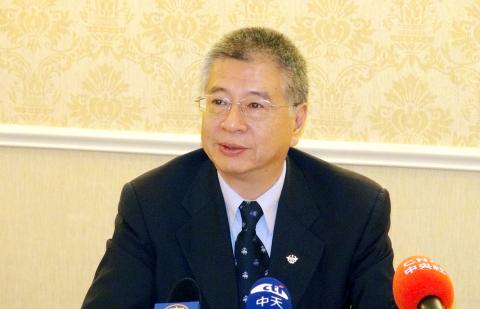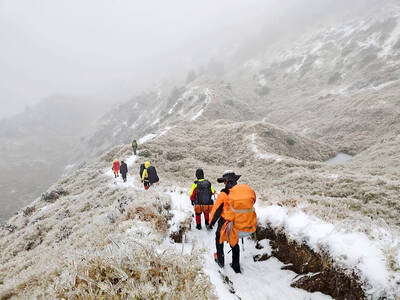Taiwan is developing “asymmetrical strategies” utilizing unconventional capabilities to counter China’s military buildup, Deputy Minister of National Defense Andrew Yang (楊念祖) said at a conference in Richmond, Virginia, on Monday.
In a keynote speech at this year’s US-Taiwan Defense Industry Conference, Yang addressed an emerging China’s impact on Asia-Pacific security, Taiwan’s response and the objectives Taiwan and the US could work on together to maintain peace and stability in the Taiwan Strait.
He described Taiwan’s asymmetrical mindset as one of “David against Goliath” to deal with the growing military imbalance across the Taiwan Strait.

Photo: CNA
“In combination with innovative weapons and defensive countermeasure weapons, Taiwan integrates conventional and unconventional warfare flexibility to create cost-efficient, highly efficient and attainable ‘asymmetric/innovative’ powers,” Yang said.
That way, Taiwan can maximize its advantages to hit the most vulnerable parts of the enemy, sabotage the enemy’s operations and gain mobility, he said.
“This is exactly how size does not matter,” he said.
Yang also stressed that Taiwan cannot produce weapons indigenously for technological or cost reasons and has to buy them from other countries.
“Everything we want to buy is defensive because we need to replace our outdated weapons with new ones, instead of engaging in an arms race,” Yang said.
On reports that the US has decided to offer Taiwan an upgrade to its F-16A/B fleet, but not the more advanced F-16C/D aircraft that Taipei had hoped to acquire, Yang reaffirmed that Taiwan needs the more advanced fighters to replace the air force’s aging F-5E/Fs.
The advanced jet fighters and diesel-electric submarines that Taiwan has also requested both have a direct impact on peace and stability in the Taiwan Strait, Yang said.
He also pledged that Taiwan would never provoke hostilities or launch a first strike, but said that it needed to protect itself and take countermeasures if it came under attack.
Taiwan had to have the ability to survive a first strike, to counter decapitation strikes, initiate mobile counterstrikes and survive prolonged operations, he said.
If an enemy initiated an attack, Taiwan would have to draw on its advantages by employing its defensive countermeasure capabilities to hit key military targets and amphibious troops assembling at ports, he said.
As a battle progressed, Taiwan would place more emphasis on joint interdiction and joint anchorage attacks to stop the enemy from traveling across the Taiwan Strait and delay their arrival in Taiwan, he said.
Also speaking at the conference, Joseph Wu (吳釗燮), a former representative to the US under the previous Democratic Progressive Party administration, said if the US rejected the sale of F-16C/Ds because of pressure from China, it would be even harder for it to sell more sensitive weapons to Taiwan.
Wu, who said the US had been lukewarm to selling new fighters to Taiwan in the past, said it was not a good thing for the F-16C/Ds to become the focus of the international community, because Taiwan’s needs for equipment related to naval and joint warfare operations could be affected.
He said if the US felt caught between Chinese pressure and its obligations under the Taiwan Relations Act, it could provide technological assistance to help Taiwan produce defensive weapons, such as smaller submarines, and build a self-sufficient defense industry.

Trips for more than 100,000 international and domestic air travelers could be disrupted as China launches a military exercise around Taiwan today, Taiwan’s Civil Aviation Administration (CAA) said yesterday. The exercise could affect nearly 900 flights scheduled to enter the Taipei Flight Information Region (FIR) during the exercise window, it added. A notice issued by the Chinese Civil Aviation Administration showed there would be seven temporary zones around the Taiwan Strait which would be used for live-fire exercises, lasting from 8am to 6pm today. All aircraft are prohibited from entering during exercise, it says. Taipei FIR has 14 international air routes and

The Ministry of National Defense (MND) today released images of the military tracking China’s People's Liberation Army (PLA) movements during the latest round of Chinese drills around Taiwan. The PLA began "Justice Mission 2025" drills today, carrying out live-fire drills, simulated strikes on land and maritime targets, and exercises to blockade the nation's main ports. The exercises are to continue tomorrow, with the PLA announcing sea and air space restrictions for five zones around Taiwan for 10 hours starting from 8:30am. The ministry today released images showing a Chinese J-16 fighter jet tracked by a F-16V Block 20 jet and the

Snow fell on Yushan (Jade Mountain, 玉山) yesterday morning as a continental cold air mass sent temperatures below freezing on Taiwan’s tallest peak, the Central Weather Administration (CWA) said. Snowflakes were seen on Yushan’s north peak from 6:28am to 6:38am, but they did not fully cover the ground and no accumulation was recorded, the CWA said. As of 7:42am, the lowest temperature recorded across Taiwan was minus-5.5°C at Yushan’s Fengkou observatory and minus-4.7°C at the Yushan observatory, CWA data showed. On Hehuanshan (合歡山) in Nantou County, a low of 1.3°C was recorded at 6:39pm, when ice pellets fell at Songsyue Lodge (松雪樓), a

NO SHAME IN RETREAT: Hikers should consider turning back if the weather turns bad or if they do not have sufficient equipment, the Taroko park headquarters said Two people died of hypothermia over the weekend while hiking on Hsuehshan (雪山), prompting park authorities to remind hikers to bring proper equipment and consider their physical condition before setting out in the cold weather. Temperatures dropped over the weekend, bringing snow to high altitudes in Shei-pa National Park. One hiker, surnamed Lin (林), who on Friday was traveling with a group of six along the Hsuehshan west ridge trail, lost consciousness due to hypothermia and died, the Shei-pa National Park Headquarters said. On Saturday, another hiker, surnamed Tien (田), in a group of five on the southeast of the west